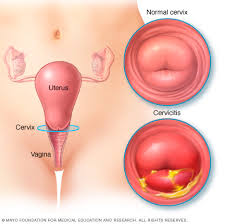Cervicitis Causes, Symptoms, Diagnosis and Treatment

What Is Cervicitis?
Cervicitis is the inflammation of the cervix, the lower part of the uterus which extends to the vagina. The inflammation may be due to irritation, infection or injury of cells which line the cervix.
Cervicitis in women has features which mirror those exhibited by men suffering from urethritis. If not treated promptly, it may prove to be fatal. In order to treat cervicitis, it is important to identify the root cause and treat it.
As the cervix hinders the entrance of bacteria and viruses into the uterus, Cervicitis may lead to an increased risk of infections ad HIV in women.
Causes Of Cervicitis:
Cervicitis occurs mainly due to sexually transmitted infections. These infections may include:
- Chlamydia
- Gonorrhea
- Herpes virus (genital herpes)
- Human papilloma virus (genital warts)
- Trichomoniasis
Other things which may lead to the development of cervicitis include:
- A device inserted into the pelvic area such as a cervical cap, diaphragm, or pessary
- Allergy to spermicides used for birth control
- Allergy to latex in condoms
- Exposure to a chemical
The following are more likely to develop cervicitis:
- Those who have high-risk sexual behavior
- Those who have a history of STIs
- Having many sexual partners
- Being Sexually active at an early age
- Having sexual partners who have engaged in high-risk sexual behavior or have had an STI
Symptoms Of Cervicitis:
Most women suffering from cervicitis may not experience any symptoms.
In case symptoms do occur, it may include the following:
- Grayish or pale yellow vaginal discharge
- Abnormal vaginal bleeding, such as bleeding after sex or between periods
- Pain during sex
- Difficult, painful, or frequent urination
- Pelvic or abdominal pain or fever, in rare cases
Diagnosis Of Cervicitis:
Cervicitis is diagnosed via physical examination.
Physical examination may consist of:
- A pelvic exam.
- A specimen collection, to test for infections
Treatment Of Cervicitis:
There is no standard treatment available for cervicitis. However, without treatment cervicitis can last for years and symptoms may worsen.
Available treatments depends upon determining the root cause of cervicitis and then treating it.
Treatment may include:
- antibiotics to kill any infections
- Antiviral medication, for viral infections.
- watchful waiting, especially after childbirth
- Cryosurgery or silver nitrate in severe cases when there is damage to cervical cells
Cryosurgery involves using freezing temperatures to freeze abnormal cells in the cervix, which then destroys them.
Silver nitrate may also be used to destroy abnormal cells.
By : Natural Health News




